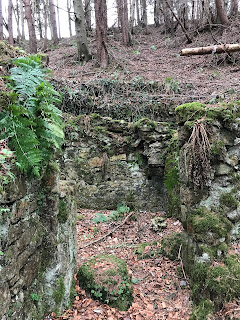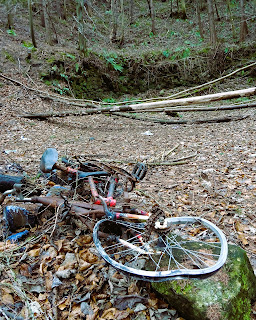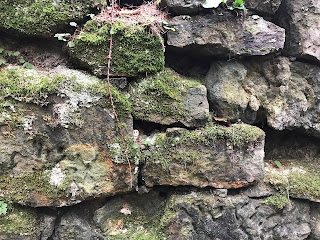It was one of those warm, winter days, when the sun is out, and you feel that spring might come early. A good day for a walk. Having recently come across some maps of walks around Gore Glen, by Gorebridge, I decided to follow one and have a nice woodland walk. So, I took a train from Edinburgh to Gorebridge and set out. However, my map reading skills and sense of direction are so bad that I ended up doing a bizarre route that took me to the back of some sewage works and then on to a path that looked like it had been made by deer rather than people, which led up a steep embankment and into some grounds I probably wasn’t meant to be in. Finally I ended up back in Gorebridge and then back on the proper path again. I followed this and ended up in the woods where I came across the ruins of the Stobsmill Gunpowder Works.
I wandered around the crumbling remains of
the buildings that once housed a thriving and somewhat dangerous industry. The stone walls were being subsumed back into
nature and were moss covered with ferns growing from the gaps and cracks. Birds sang in the trees above and water bubbled
in the nearby stream. It was all very
different a couple of hundred years ago when there would have been dozens of
men at work in and around the buildings, and water wheels would have been churning
away to power the whole operation.
In 1794 the works at Stobsmill were
constructed for the Hitchener and Hunter Company to start producing
gunpowder. You might think that this was
a company well versed in the production of such an explosive material, but no,
it was the venture of William Hitchener, a millwright, and John Hunter, a
farmer. They were both originally from
Surrey and had applied there for a licence to produce gunpowder but had been
turned down as they lacked the necessary skills or experience to run such a
dangerous business. Somehow, they had found their way to Gorebridge where,
along with a more experienced partner, John Merrick, they applied for and were
successful in gaining a licence to manufacture gunpowder.
The works were constructed in an
isolated area within the shelter of a valley near to Gorebridge. The valley was used as a natural barrier in
case an explosion occurred, and artificial mounds were created and planted with
trees to lessen any explosion that might happen. The works were built by the Gore Water, with
the river being channelled and used to drive the ten waterwheels that powered
them.
The gunpowder produced at the works was
exported all around the world and was used by the British Army during the
Napoleonic Wars.
As you might expect in an era when
health and safety concerns were minimal, there were quite a few accidents at
the works and several large explosions.
In 1803 an explosion occurred that killed John Hunter, who was in his
garden when a large stone from the blast tore off his arm. Two of the men working at the mill were also
killed in that explosion.
On the morning of 18 February 1825 an
explosion occurred that was so big it could be heard in Fife, and it rattled
the windows of those living in Edinburgh, eight miles away. It was also reported that the shockwave from
the explosion caused the church bells in Dalkeith, some five miles away, to
start ringing and that a ploughman working in a field almost a mile away was
thrown thirty yards by the force of the blast.
Luckily, he was unharmed. While
in the nearby village of Gorebridge the windows of all the houses were blown
in.
Shortly before the explosion, two of the
workmen at the mill, Richard Cornwall and Walter Thomson, had been busy loading
casks of gunpowder from the ‘Drying Room’ on to a horse drawn waggon. The casks were then to be taken to a store in
another building a short distance away.
Cornwall, at some point went back into the ‘Drying Room’ to retrieve
more casks, while Thomson was loading them on to the waggon. Something then triggered a huge explosion in
the ‘Drying Room’, which in turn also caused the store to explode. These buildings were completely destroyed and
both Cornwall and Thomson were blown to pieces.
A report at the time describes how the mangled fragments of the men’s
bodies were found scattered around over the distance of a mile and that it was
impossible to tell which of the fragments belonged to which man. Other workers on the site were reported to
have been blown to the ground, with some throwing themselves into the river in
search of safety. While the body of the
horse that had been with the waggon was found thirty yards from the explosion
and the trees all around were shattered and broken. Some passers-by, who had been on the high
road at the time of the explosion described a huge column of black smoke rising
up from the valley and large stones being thrown up from it, like a volcano.
It was reckoned that about 60 barrels of
gunpowder had exploded, each of these containing 112 lbs (51 kg) of powder. So
in total over 3000kg of gunpowder. You
would think that given an explosion of that enormity the mills might close
down, but no, given a business that lucrative and that vital to war, Empire,
etc., they carried on. Then in 1827
there was another explosion…
On Saturday 29 September 1827 at around seven
thirty in the morning the residents of Gorebridge were woken by a loud blast when
the ‘Corning House’ (the building in which the powder was separated into
granules) at the gunpowder works exploded.
The horrific scene that met those who hurried to the ruined building to
help was described graphically in a report of the incident by the Caledonian
Mercury –
‘…the three men who were employed in the
premises at the time…were killed by the explosion. One of the unfortunate men had his legs torn
from his body; another his belly torn open, and his entrails hanging out; and
the third was blown into the water at a considerable distance from the Mill,
where he was found dead about an hour after.
Search was immediately made for the members which were severed from the
bodies: but when found, they were so dreadfully mutilated, that it was
impossible to know to which the different members belonged. When looking around the scene of this
terrible visitation, it seemed as if some destroying angel had been there,
doing his work of desolation and death. The
premises wherein the explosion took place…lay in one heap of ruins; the
surrounding trees were stript of their foliage; and the grass was burnt black
and bare…’
Now, you may be thinking that given the
amount of accidents at Stobsmill, those working there were a bit careless, or
that the owners were unduly lax over health and safety, and uncaring when it
came to their workforce. However, it
seems that explosions at gunpowder factories were not that uncommon, that they
were just one of the dangers of working in that trade. A few days after the explosion at Stobsmill, there
was an explosion at the premises of Messrs Pigou & co, a Powder Mill in
Dartford, Kent. Three workmen were also
killed in that explosion.
Anyway, the buildings at Stobsmill were
repaired and work carried on. Then on
Wednesday 21 March 1838, at around six thirty in the morning there was another
explosion. The working day had begun
around half an hour earlier and the workforce was spread out throughout the
site engaged in their various tasks. In
the ‘Corning House’ two men, Robertson, and West, were busy at work when there
was a huge blast that destroyed the building.
Their colleagues ran to the smoking ruins and in the rubble they found Robertson. He was still breathing but died shortly after
from his wounds. The body of West was
then found ‘at some distance’ from the building. A report of the incident in The Scotsman
notes that the damage to the buildings and machinery was significant and that ‘the
loss to the proprietor must be considerable – insurance on property of this nature
being of course out of the question.’ No
shit Sherlock!
Again the buildings were repaired, and
work carried on until around 1861 when the mills finally closed. Now all that is left of them are the ruins in
the woodland of the Gore Glen. A place
so peaceful that it is hard to imagine that it was once a site of heavy
industry and several tragic, fatal, and devastating accidents.
I left the Skulferatu that had
accompanied me on my walk in a moss and lichen covered hollow in one of the
walls.
The coordinates for the location of the Skulferatu
are –
Latitude 55.83960
Longitude -3.051440
I used the following sources for
information on Stobsmill Gunpowder Works -
The Statistical Accounts
of Scotland 1791-1845, Vol 1
Temple, County of
Edinburgh (Page 53)
Gorebridge Community
Development Trust
https://gorebridge.org.uk/heritage/stobsmill-gunpowder-works-an-introduction/
The Scots Magazine
Tuesday, 1 March 1825
Caledonian Mercury
Saturday, 19 February
1825
Caledonian Mercury
Monday, 1 October 1827
The Scotsman
Wednesday, 28 March 1838
Article and photographs are copyright of © Kevin Nosferatu, unless otherwise specified.















